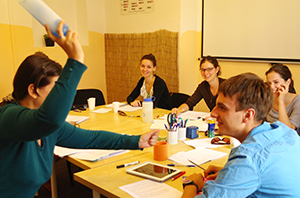 The Czech Language Training (CLT) school is located directly opposite the tram stop Husinecká, one stop from the Central Station. It's a Thursday night and I´m standing at the door of the school on the 3rd floor. I ring the bell and a buzzer opens the door for me. I am welcomed by a graffiti drawing of a tree – it is a signpost directing me to the class number 4, where my lesson takes place. At first glance, CLT looks cosy and homely. Tags with Czech labels are stuck on various subjects, an aid to teaching vocabulary giving the impression of being in some student´s home.
The Czech Language Training (CLT) school is located directly opposite the tram stop Husinecká, one stop from the Central Station. It's a Thursday night and I´m standing at the door of the school on the 3rd floor. I ring the bell and a buzzer opens the door for me. I am welcomed by a graffiti drawing of a tree – it is a signpost directing me to the class number 4, where my lesson takes place. At first glance, CLT looks cosy and homely. Tags with Czech labels are stuck on various subjects, an aid to teaching vocabulary giving the impression of being in some student´s home.
Several students are in the "Cafe" - a common room for students waiting for their Czech lessons. Some engage in friendly English conversation, others, probably advanced students in Czech and the remainder ponder deeply over their textbooks of Czech for foreigners, doing homework or revising the course. I ask them where they are from and why they are studying Czech for foreigners. Answers are from different countries: ranging from Tunisia, Germany, Great Britain, Russia, Ukraine, Israel, the Netherlands, Japan, Costa Rica, to the USA ... Reason why they are studying Czech for foreigners is similar for most students. They live and work here or study at Czech schools and universities and either want to communicate with the Czechs in their native language, or they are simply interested in the language and the culture. They also often have Czech partners, who help them with their Czech language. The students go together to film screenings and other events organized by the CLT in addition to the „classic" education.
At 6.30 pm, the door to classroom no. 4 door opens and the students of previous lesson leave with the sounds of laughter. Our charming lecturer Martina welcomes us in. The classroom is full of study aids that the students created. Posters with national dishes and recipes are hung in one part of the room, useful phrases for beginners and advanced students are hung on the other side. There are dictionaries and surprisingly also building kits for children on the table. Martina says that it's "a small town", which she put together with her students and which helps them to practice prepositions and cases. The classroom has just 7 comfortable chairs for students and 1 for a teacher because the CLT school guarantees a maximum of 7 students in the class. I am very surprised by other equipment that is available in the classroom - a projector, a screen and a laptop. Martina explains to me that this is standard equipment for all classrooms in the school.
I am in a group that is already at the intermediate level. First, we introduce ourselves to each other and to warm everyone up, we perform a pantomime to demonstrate our hobbies. The rest of the group guesses what we like doing. The group is evidently used to these informal, drama activities and unlike me doesn’t feel embarrassed. For today's lesson, Martina prepared an internet article, which presents the opinions of several foreigners on the behaviour of the Czechs. First, we discuss and guess in groups what the article is about. From the beginning I find communicating with foreigners in Czech very surprising. When I speak slowly, they understand almost everything I say and can fluently express their thoughts. After this activity, we read the article quickly and see if our guesses our right. Martina engages me in the lesson even more and lets me explain unfamiliar words to students. Then we practice the new vocabulary in a competition. Martina has prepared additional questions that test whether students have understood everything. After the questions an exercise in grammar follows, practising the current subject matter. Once that is complete, it is up to the students themselves to discuss in small groups what they find surprising about the Czechs, what bothers them, what they admire and what they actually think about the Czechs. Martina and I created a special "committee" that comments on individual presentations and contributions. During the presentations Martina writes down all the "serious” mistakes so that she can analyse and correct them immediately after the presentations. At the end, we get one last task. In new groups we shall choose one Czech custom and present it in a short sketch. Others guess what tradition we perform. As homework students are asked to write a short text about their home nation setting out how they believe perceived by those around them. I thank the lecturer Martina as well as the students in the class. We leave the class together, in such as good a mood as the previous students. The lesson went incredibly fast.
Martina also revealed to me that some of her students have been studying Czech for foreigners with her already for three years, having short breaks, which is allowed by the monthly enrolment. They also improve their Czech on courses and lessons at the pronunciation centre. There is a “senior” student in the class, who has begun studying the beginner’s course already 6 years ago.
I'm glad I was able to experience the lesson of Czech for foreigners. Now I'm going to persuade every foreigner I meet to speak Czech with us.
Good luck to all students of Czech for foreigners at the Czech Language Training classes!

